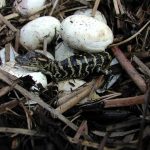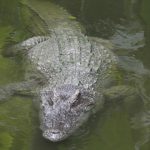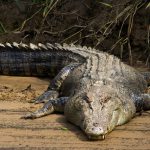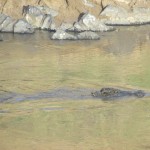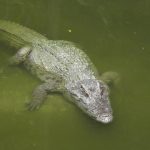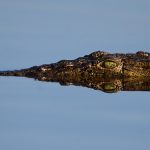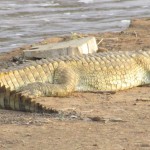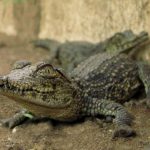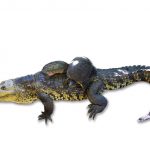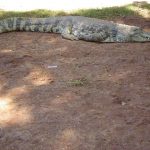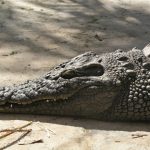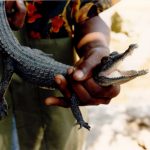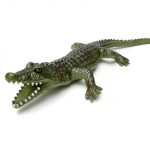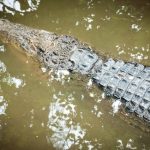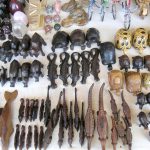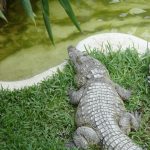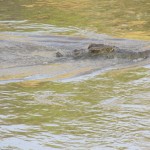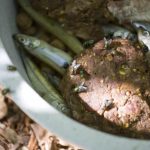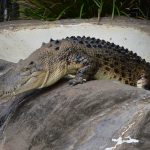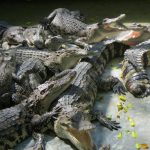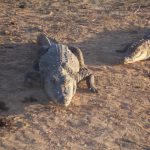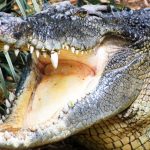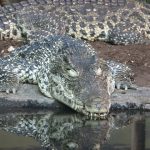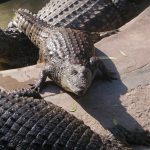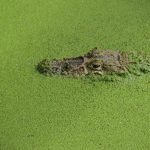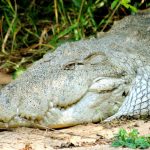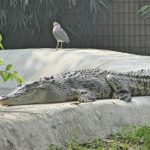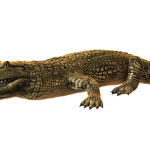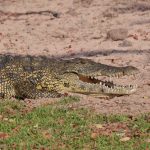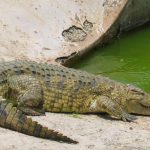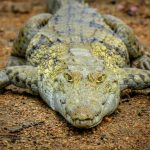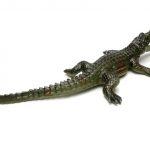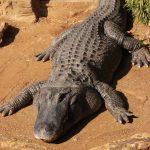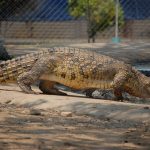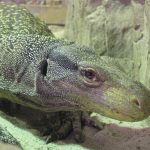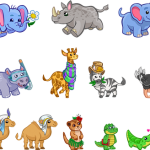- Dwarf Nile crocodiles live in the Sahara Desert and in Mali
- A crocodile in Africa is renowned for its aggressive nature
- African crocodiles grow to five metres in length and 118st in weight
- Crocodile farming in Kenya comes with its challenges but you can make more than 100% in profits
- In the wild attacks on human beings are commonplace but most incidents go unreported
- Crocodiles in farms are fed with blood-soaked maize, fish, and other meats
- In the wild attacks on human beings by crocodiles are commonplace but the figures are unavailable because the incidents go unreported
- Crocodiles live in freshwater marshes, mangrove swamps, and rivers throughout the Nile Basin, Madagascar, and the sub-Saharan Africa
- A member of staff at Collins Mueke’s crocodile farm lost his index finger by a young crocodile a few weeks old
- Collins Mueke’s crocodile farm is in Kenya
- Crocodiles in farms are fed with blood-soaked maize, meat, and fish
- In the wild attacks on human beings by crocodiles are commonplace but the exact figures are unavailable because the incidents go unreported
- Wild attacks on human beings by crocodiles are commonplace but the figures are unavailable
- Crocodiles in Africa typically weigh as much as 750kg and grow to five meters in length
- The scientific name of crocodile is Crocodylinae
- The African crocodile is said to kill hundreds every year but the exact figures are not available because the incidents go unreported
- Crocodile meat is in high demand from China and the restaurants of upmarket tourist hotels
- Crocodile farming has its challenges
- The African crocodile is said to kill hundreds every year in Kenya but the exact figures are unavailable because the incidents go unreported
- The Nile crocodile inhabits a range of aquatic habitats
- Alligators and crocodiles are cousins
- Dwarf Nile crocodiles live in the Sahara Desert and Mali
- In the wild attacks on human beings by crocodiles are commonplace but most incidents go unreported
- The enclosures in crocodile farms have steep walls to prevent them from escaping
- In Kenya crocodile farming comes with its challenges
- Crocodiles and alligators are cousins
- American crocodiles are known as Crocodylus acutus
- Crocodile farming industry is small but growing
- Crocodile meat is said to taste similar to chicken
- An Africa crocodile is renowned for its aggressive nature
- In Kenya farming of Nile crocodiles poses no problem because they are not considered endangered
- American crocodiles have slender, long snouts
- Crocodiles in America are olive-green or gray-green
- Juvenile crocodiles are dark olive brown
- In Kenya there are 21 crocodile farmers but 60 more have applied for the required licences
- African crocodiles grow to five meters in length and 750kg in weight
- Nile crocodiles are said to taste delicious
- Crocodiles are large aquatic reptiles
- African crocodiles, typically weighing 750kg and 16ft in length, are renowned for their aggressive nature
- A Nile crocodile’s main diet is fish but it can attack almost anything that crosses its path, including zebras, porcupines, small hippos, birds, and other crocodiles
- In Kenya crocodile farming comes with its challenges but you can make more than 100% in profits
- African crocodiles grow to 16ft in length and 750kg in weight
- Crocodiles live in freshwater marshes, rivers, and mangrove swamps
- Crocodile farming industry is small, but growing
- The African crocodile is said to kill hundreds every year in Kenya but the figures are not available because the incidents go unreported
- In the wild attacks on humans by crocodiles are commonplace but the exact figures are not available because the incidents go unreported
- In the wild attacks on human beings by crocodiles are commonplace but most incidents go unreported
- Crocodiles account for a few hundred disappearances and deaths each year
- Crocodiles live throughout Madagascar, sub-Saharan Africa, and the Nile basin
- African crocodile grows to five meters in length and 750kg in weight
- Crocodile meat is in high demand from the restaurants of upmarket tourist hotels and China
- Crocodiles in America are known as Crocodylus acutus
- The hides of crocodiles are used to make shoes, belts and handbags
- The African crocodile is said to kill hundreds every year in Kenya but the figures are unavailable because the incidents go unreported
- Nile crocodiles in Kenya are said to taste delicious but other crocodiles are easier to look after
- The African crocodile is said to kill hundreds every year
- The crocodile meat is white in color
- Nile crocodiles are said to taste delicious but other crocodiles are easier to look after
- There are 33,000 crocodiles at Collins Mueke’s crocodile farm, a 300-acre facility 180km from the capital Nairobi
- A member of staff at Collins Mueke’s crocodile farm was killed by a crocodile when he turned his back to answer his mobile phone
- Small crocodile head in the water
- In the wild attacks on human beings by crocodiles are commonplace but the exact figures are not available because the incidents go unreported
- Crocodile meat is in high demand from the restaurants of upmarket tourist hotels
- Wild attacks on humans by crocodiles are commonplace but the figures are not available
- Crocodiles in Africa grow to five meters in length and typically weigh as much as 750kg
- African crocodiles grow to 118st in weight and five metres in length
- An African crocodile, typically weighing 750kg and 16ft in length, is renowned for its aggressive nature
- A Nile crocodile’s main diet is fish but it can attack almost anything
- Throughout Africa crocodiles account for a few hundred disappearances and deaths each year
- African crocodiles are renowned for their aggressive natures
- Crocodile farming has its challenges but you can make more than 100% in profits
- The Nile crocodile and the Salt Water Crocodile have been known to eat human beings
- Collins Mueke’s crocodile farm is in eastern Kenya
- African crocodile grows to 118st in weight and five metres in length
- Crocodile meat is in high demand from China and from the restaurants of upmarket tourist hotels in Nairobi
- In Kenya there are 21 crocodile farmers but 60 more have applied for the licences, according to KWS
- Crocodile meat is white in color
- Crocodile farming in Kenya comes with its challenges
- In Kenya there are 21 crocodile farmers
- The African crocodile is said to kill hundreds every year in Kenya but the exact figures are not available because the incidents go unreported
- Wild attacks on humans by crocodiles are commonplace but the exact figures are not available
- In the wild attacks on human beings are commonplace but the incidents go unreported
- The start-up costs of crocodile farms are very high
- South Africa leads the pack in crocodile farming across Africa followed by Zambia, Kenya and Zimbabwe
- Crocodile meat is white meat
- Wild attacks on human beings by crocodiles are commonplace but the figures are not available
- South Africa leads the pack in crocodile farming followed by Zambia
- America crocodiles are either olive-green or gray-green
- In China, crocodile meat is very popular
- Crocodile farming is a dangerous, but lucrative world
- All members of Crocodylinae are considered true crocodiles
- Crocodiles live throughout the tropics in Asia, Africa, the Americas and Australia
- Crocodile meat is said to taste like chicken and is white in color
- The African crocodile is said to kill hundreds every year but the exact figures are unavailable
- The African crocodile is said to kill hundreds every year in Kenya but the exact figures are unavailable
- KONICA MINOLTA DIGITAL CAMERA
- South Africa leads the pack in crocodile farming according to industry estimates
- America crocodiles are either olive-green or gray-green in color
- A Nile crocodile can attack almost anything that crosses its path
- Crocodiles live in mangrove swamps, freshwater marshes, and rivers
- Crocodiles live in mangrove swamps, rivers, and freshwater marshes
- The start-up costs of a crocodile farm is very high
- The start-up costs of crocodile farms are onerous
- South Africa leads the pack in crocodile farming
- In Kenya there are 21 crocodile farmers but 60 more have applied for the licences
- Crocodylus acutus is the name of American crocodiles
- A Nile crocodile’s main diet is fish but it can attack almost anything that crosses its path, including zebras, porcupines, birds, small hippos, and other crocodiles
- Farming of Nile crocodiles in Kenya poses no problem because they are not endangered
- Nile crocodile meat is said to taste delicious
- In the wild attacks on human beings by crocodiles are commonplace but the exact figures are not available
- The African crocodile is said to kill hundreds every year in Kenya but the figures are not available because the incidents go unreported
- Crocodile meat is in high demand from China
- African crocodile grows to five meters in length and typically weighs as much as 750kg
- Crocodile farming is growing at 22% per year
- There are 21 crocodile farmers in Kenya but 60 more have applied for the required licences
- African crocodiles, typically weighing 750kg and five metres in length, are renowned for their aggressive nature
- Crocodiles are cannibalistic
- A Nile crocodile’s main diet is fish but it can attack almost anything that crosses its path
- Crocodile meat is very popular in China
- A Nile crocodile’s main diet is fish but it can attack almost anything that crosses its path, including zebras, birds, small hippos, porcupines, and other crocodiles
- In the wild attacks on humans by crocodiles are commonplace but the incidents go unreported
- The crocodile farming industry is small
- American crocodiles are called Crocodylus acutus
- In the wild attacks on humans by crocodiles are commonplace but the exact figures are not available because the incidents go unreported
- Small crocodile head in the water
- The Nile crocodile inhabits aquatic habitats, including rivers, large freshwater lakes, mangrove swamps, freshwater swamps, and coastal estuaries
- A member of staff at Collins Mueke’s crocodile farm lost his index finger by a young crocodile
- Crocodile meat is in high demand from the restaurants of upmarket tourist hotels and from China
- African crocodile grows to 750kg in weight and five meters in length
- Dwarf Nile crocodiles is said to live in the Sahara Desert and Mali
- African crocodiles, typically weighing 118st and five metres in length, are renowned for their aggressive nature
- African crocodiles typically weigh as much as 750kg and grows to five meters in length
- The African crocodile is said to kill hundreds every year in Kenya but the incidents go unreported
- The African crocodile is said to kill hundreds every year in Kenya but the exact figures are not available
- Crocodiles account for a few hundred disappearances and deaths each year in Kenya
- The hides of crocodiles are used to make belts, shoes and handbags
- In the wild attacks on humans by crocodiles are commonplace but the exact figures are not available
- Farming of crocodiles in Kenya poses no problem because they are not considered endangered
- A Nile crocodile’s main diet is fish but it can attack almost anything that crosses its path, including zebras, birds, porcupines, small hippos, and other crocodiles
- The largest species of African crocodile are deadly predators
- Crocodile farming comes with its challenges
- South Africa leads the pack in crocodile farming followed by Zambia, Kenya and Zimbabwe
- Crocodile meat is in high demand from the restaurants of upmarket tourist hotels in Nairobi and from China
- Crocodylus acutus are crocodiles in America
- Big crocodile looking right at the camera
- The start-up costs of a crocodile farm are onerous
- Crocodile farming industry is small
- There are 21 crocodile farmers in Kenya but 60 more have applied for the licences
- An African crocodile, typically weighing 750kg and five metres in length, is renowned for its aggressive nature
- Crocodiles account for a few hundred disappearances and deaths each year throughout Africa
- Crocodiles in American are well-armored with scaly tough, skin
- A Nile crocodile can attack anything that crosses its path
- Farming of crocodiles poses no problem because they are not endangered
- American crocodiles have long, slender snouts
- There are 21 crocodile farmers in Kenya but 60 more have applied for the licences, according to KWS
- African crocodiles grow to 118st in weight and 16ft in length
- The next biggest crocodile export market is the Middle East region
- Farming of Nile crocodiles poses no problem because they are not considered endangered
- African crocodile grows to 16ft in length and 118st in weight
- All members of Crocodylinae are considered crocodiles
- Crocodile meat is in high demand
- Some species of crocodiles have legendary tempers
- The next biggest crocodile export market is the Middle Eastern region
- Crocodiles in America are called Crocodylus acutus
- American crocodiles are olive-green or gray-green
- Nile crocodile is said to taste good but other crocodiles are easier to look after
- Nile crocodile meat is said to taste good
- Attacks on humans by crocodiles In the wild are commonplace
- Crocodile meat is in high demand from the restaurants of upmarket tourist hotels in Nairobi
- Farming of Nile crocodiles in Kenya poses no problem because they are not considered endangered
- The crocodile farming industry is small, but growing
- In the wild attacks on human beings by crocodiles are commonplace but the figures are not available because the incidents go unreported
- Farming of crocodiles poses no problem because they are not considered endangered
- A Nile crocodile’s main diet is fish but it can attack anything that crosses its path, including zebras, birds, small hippos, porcupines, and other crocodiles
- The African crocodile is said to kill hundreds every year in Kenya
- In Africa crocodile farming is growing at 22% per year
- Crocodiles in American are well-armored with scaly and tough, skin
- There are 21 crocodile farmers in Kenya
- In Kenya crocodile farming has its challenges
- The largest species of African crocodile are deadly predators
- Crocodiles live in freshwater marshes, mangrove swamps, and rivers
- African crocodiles, typically weighing 118st and 16ft in length, are renowned for their aggressive nature
- South Africa leads the pack in crocodile farming according to industry estimates followed by Zambia
- Crocodiles live in rivers, freshwater marshes, and mangrove swamps
- In the wild attacks on humans by crocodiles are commonplace but the figures are not available because the incidents go unreported
- South Africa leads the pack in crocodile farming according to industry estimates followed by Zambia, Kenya and Zimbabwe
- In Kenya crocodile farming has its challenges but you can make more than 100% in profits
- The African crocodile is said to kill hundreds every year but the exact figures are not available
- African crocodile grows to 118st in weight and 16ft in length
- Crocodile leather shoes remain popular all around the world
- The African crocodile is said to kill hundreds every year but the incidents go unreported
- Crocodiles in America are either olive-green or gray-green
- In the wild attacks on humans by crocodiles are commonplace
- In Kenya there are 21 crocodile farmers but 60 more have applied for the licences, according to KWS, a government agency
- In the wild attacks on humans by crocodiles are commonplace but the exact figures are unavailable because the incidents go unreported
- Nile crocodile meat is said to taste delicious but other crocodiles are easier to look after
- Farming of Nile crocodiles poses no problem because they are not endangered
- Farming of crocodiles in Kenya poses no problem because they are not endangered
- Crocodiles live in rivers, mangrove swamps, and freshwater marshes
- American crocodiles have long and slender snouts
- Wild attacks on human beings by crocodiles are commonplace but the exact figures are not available
- In Kenya farming of crocodiles poses no problem because they are not considered endangered
- A Nile crocodile’s main diet is fish but it can attack anything that crosses its path
- Crocodile farming is growing at 22% per year in Africa
- Crocodile meat is in high demand from the restaurants of upmarket tourist hotels in Nairobi and China
- Crocodiles live in freshwater marshes, mangrove swamps, and rivers throughout Madagascar, sub-Saharan Africa, and the Nile Basin
- Crocodile meat is white
- Crocodile leather shoes remain popular all over the world
- Crocodiles live in rivers, freshwater marshes, and mangrove swamps, throughout the Nile Basin, Madagascar, and the sub-Saharan Africa
- Crocodile leather shoes remain popular globally
- In the wild attacks on human beings by crocodiles are commonplace but the incidents go unreported
- Crocodile farming is dangerous, but lucrative
- Wild attacks on humans by crocodiles are commonplace but the exact figures are unavailable
- There are 21 crocodile farmers in Kenya but 60 more have applied for the licences, according to KWS, a government agency
- Crocodylus acutus are American crocodiles
- The crocodile farming industry is small but growing
- American crocodiles have slender and long snouts
- Crocodile farming in Kenya has its challenges but you can make more than 100% in profits
- The hides of crocodiles are used to make belts, handbags and shoes
- The Nile crocodile and the Salt Water Crocodile have been known to eat people
- Wild attacks on humans by crocodiles are commonplace
- Crocodiles live throughout Madagascar, the Nile basin, and sub-Saharan Africa
- Even baby crocodiles can cause injury
- The African crocodile is said to kill hundreds every year but the exact figures are unavailable because the incidents go unreported
- In the wild attacks on human beings by crocodiles are commonplace but the figures are not available
- Wild attacks on human beings by crocodiles are commonplace
- Crocodile farming is growing at 22% per year in Africa according to industry estiimates
- Wild attacks on human beings by crocodiles are commonplace but the exact figures are unavailable
- The African crocodile is said to kill hundreds every year but the figures are not available because the incidents go unreported
- A Nile crocodile’s main diet is fish but it can attack anything that crosses its path, including zebras, porcupines, small hippos, birds, and other crocodiles
- Crocodiles live in freshwater marshes, mangrove swamps, and rivers, throughout the Nile Basin, Madagascar, and the sub-Saharan Africa
- The Nile crocodile inhabits a range of aquatic habitats, including coastal estuaries, rivers, large freshwater lakes, mangrove swamps, and freshwater swamps
- Crocodiles in American have slender, long snouts
- African crocodile grows to 16ft in length and 750kg in weight
- South Africa leads the pack in crocodile farming across Africa according to industry estimates followed by Zambia, Kenya and Zimbabwe
- African crocodiles grow to 16ft in length and 118st in weight
- African crocodile grows to 750kg in weight and 16ft in length
- In the wild attacks on humans by crocodiles are commonplace but most incidents go unreported
- An African crocodile, typically weighing 118st and 16ft in length, is renowned for its aggressive nature
- Crocodile meat is in high demand from China and the restaurants of upmarket tourist hotels in Nairobi
- The hides of crocodiles are used to make handbags, belts and shoes
- African crocodile grows to five metres in length and 118st in weight
- Nile crocodile meat is said to taste good but other crocodiles are easier to look after
- Crocodile leather shoes remain popular around the world
- The Nile crocodile inhabits aquatic habitats, including coastal estuaries, rivers, large freshwater lakes, mangrove swamps, and freshwater swamps
- Crocodile meat is said to taste similar to chicken and is white in color
- The African crocodile is said to kill hundreds every year in Kenya but the exact figures are not available because the incidents go unreported
- Crocodiles in America are either olive-green or gray-green in color
- Crocodile farming in Kenya has its challenges
- In the wild attacks on humans by crocodiles are commonplace but the figures are not available
- In Kenya crocodiles account for a few hundred disappearances and deaths each year
- African crocodiles grow to 750kg in weight and 16ft in length
- Crocodile meat is in high demand from China and from the restaurants of upmarket tourist hotels
- Crocodiles live in freshwater marshes, mangrove swamps, and rivers throughout sub-Saharan Africa, Madagascar, and the Nile Basin
- The Nile crocodile inhabits a range of aquatic habitats, including rivers, large freshwater lakes, mangrove swamps, freshwater swamps, and coastal estuaries
- In Africa crocodile farming is growing at 22% per year according to industry estiimates
- A Nile crocodile’s main diet is fish but it can attack anything that crosses its path, including zebras, small hippos, birds, porcupines, and other crocodiles
- Crocodiles in Africa are renowned for their aggressive natures
- Dwarf Nile crocodiles live in Mali and the Sahara Desert
- A Nile crocodile’s main diet is fish
- Nile crocodile is said to taste delicious but other crocodiles are easier to look after
- Crocodile farming comes with its challenges but you can make more than 100% in profits
- Crocodile farming is lucrative, but dangerous
- The hides of crocodiles are used to make shoes, handbags and belts
- Crocodiles live throughout the Nile basin, sub-Saharan Africa, and Madagascar
5 facts about crocodile
- The lifespan of saltwater crocodile is 70 years
- The lifespan of nile crocodile is 70-100 years
- Crocodiles belong to Animalia kingdom
- The Swahili name for crocodile is mamba
- The average length of a crocodile is 16 to 20 feet
To receive a colourful digibook about crocodile with videos, images and text, please fill out the following form or simply email us on safaris@safari-center.com

